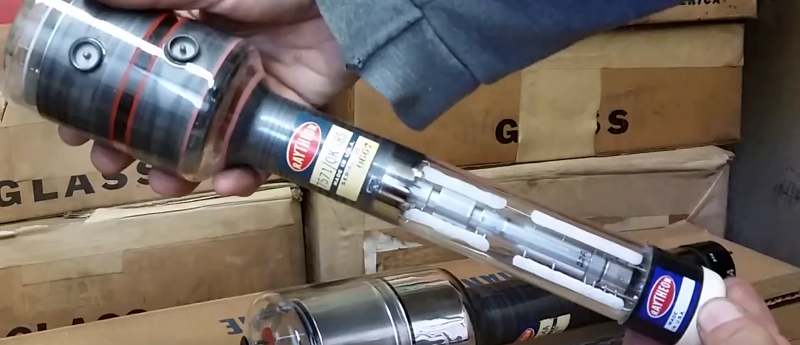A lot of people like tubes either for their audio sound or their collectible value. [Uniservo] likes oddball tubes. His recent video (see below) shows a radechon — a computer memory tube. These were apparently widely used in RADAR sets until recently and has some similarity to a Williams tube.
The tube is essentially a CRT that illuminates a sheet of mica or another dielectric instead of a phosphor screen. The dielectric has a fine mesh grid in contact with it. By depositing charge on the mica, the tube can store an analog value. In theory, the tube could store about 16 kbits of information, but in practice, the resolution was less.
The charge would persist for a few hundred milliseconds and the memory system would have to refresh the tube contents or the tube would lose its data. For binary storage, the surface gets a negative charge, or a zero charge. Some tubes used a capacitive coupling to the charged surface, while others would collect secondary electron emissions from the front of the surface.
We found a scan of a Radechon data sheet on [Nixiebunny’s] site. On the Cold War Infrastructure site, there’s a scan of an RCA ad for the beast, showing a picture of SAGE that apparently used the tubes. There are also links to some other pages about the tubes.
If you are interested in old memory tech, we took a trip down memory lane last year. We aren’t sure if you could do the same debugging trick with these that you could with a Williams tube. With those, you could hook a CRT in parallel with the tube and get a visual representation of your memory, a trick used by Baby and several other old computers.
















I’m not sure how it’s possible that I’d never heard of these until I saw it on HaD something so far up my street I can taste it. So to speak. Wonderful video
Cool, I’d heard of those… seeming like quite high density for their day, even though they look ridiculously huge now.
How on earth did people design tubes like these? How would you prototype a complex vacuum-sealed arrangement of glass? I’ve never seen any design documents for tubes and I’m really curious how it’s done.
You can prototype it without the outer glass and put it under a vacuum dome to test.
Stuck in moderation but Google for “vacuum tube design” and look for a RCA pdf.
I did an earlier video about an internal RCA document called “Electron Tube Design” – a rather thick book that outlines much of tube theory and how they developed tubes. Crummy early video, but check it out anyway. This book is now available online. There are also two huge archives that thoughtful souls pulled from dumpsters – the Dowd-RCA archive and the Eimac-Perham archive. These two archives combined consist of hundreds of shelf feet of the nitty gritty details about tube construction.
Try to understand: in the days when these were being developed, it was the dominant electronic technology. You might as well ask how people ever designed such things as submicron MOS chips today. Yes, it was expensive work, just like designing the masks for a microchip is. Which is why it was done in high-$ industrial labs, just like now.
Glass blowing was quite an art. First came the tube with a shadow of a Maltese cross on the end. Then the beam and scanning, the scope was born. Progress built on it self.
There once was a way of making a sample of a musical timbre by cutting out a piece of black paper in the shape of it’s single wave as displayed on the scope, the black paper is the half below the trace. Now the scope vertical was put into a feedback loop to keep the beam just on the edge of the paper mask as picked up by a photo tube in front with light shielding. When the horizontal was a keyboard selected frequency, the vertical was a sample at the full range of the keys. Ca.1960 or so, maybe much earlier. The paper trick probably inspired the internalization of things.
I wonder where he sources this stuff from – it’s a bit exotic for eblag isn’t it?
The EMF whizzing about on the left side of the Stereo Mic who else lives in a microwave
15 minutes of someone just holding and rotating a tube while blabbing. Guy: written blogs exist for a reason.
“…a trick used by Baby and several other old computers did.”